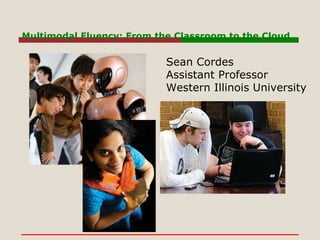Multimodal Fluency: Classroom to the Cloud
•Als PPT, PDF herunterladen•
4 gefällt mir•934 views
Presentation for Educause Midwest Regional Conference 2010, Chicago, Illinois
Melden
Teilen
Melden
Teilen

Empfohlen
Weitere ähnliche Inhalte
Was ist angesagt?
Was ist angesagt? (20)
The Modern Digital Learning Landscape: 5 Tips To Engage Gen Z and Millennial ...

The Modern Digital Learning Landscape: 5 Tips To Engage Gen Z and Millennial ...
Introduction to digital literacy for adult education esol

Introduction to digital literacy for adult education esol
Digital Literacy & Citizenship in the 21st Century

Digital Literacy & Citizenship in the 21st Century
Digital Literacy - 21st Century Workforce Development

Digital Literacy - 21st Century Workforce Development
Ähnlich wie Multimodal Fluency: Classroom to the Cloud
Ähnlich wie Multimodal Fluency: Classroom to the Cloud (20)
Currents in Information Literacy: Standards, Lessons, and Learners

Currents in Information Literacy: Standards, Lessons, and Learners
Currents in Information Literacy: Standards, Lessons, and Learners Standards,...

Currents in Information Literacy: Standards, Lessons, and Learners Standards,...
Using Technology to Create Professional Learning Opportunities

Using Technology to Create Professional Learning Opportunities
Mehr von Western Illinois University
River Wide, River Deep: Libraries, Learners, and Transformative Literacy- Ifl...

River Wide, River Deep: Libraries, Learners, and Transformative Literacy- Ifl...Western Illinois University
Handheld Tube Tours: Increasing orientation engagement with viral videos and ...

Handheld Tube Tours: Increasing orientation engagement with viral videos and ...Western Illinois University
IETC 2011-Making Information Work-Applying competency standards to improve te...

IETC 2011-Making Information Work-Applying competency standards to improve te...Western Illinois University
Mehr von Western Illinois University (20)
River Wide, River Deep: Libraries, Learners, and Transformative Literacy- Ifl...

River Wide, River Deep: Libraries, Learners, and Transformative Literacy- Ifl...
Handheld Tube Tours: Increasing orientation engagement with viral videos and ...

Handheld Tube Tours: Increasing orientation engagement with viral videos and ...
Tech Fest 2013-Presentation tools through the ages.

Tech Fest 2013-Presentation tools through the ages.
Tech Fest 2012-Evolving video Instruction development

Tech Fest 2012-Evolving video Instruction development
IETC 2011-Making Information Work-Applying competency standards to improve te...

IETC 2011-Making Information Work-Applying competency standards to improve te...
Measured Steps: An Exploratory Study in Mulitmodal Literacy and Learning

Measured Steps: An Exploratory Study in Mulitmodal Literacy and Learning
Pecha Kucha:: The lingua electric: 21st century literacy in 400 seconds

Pecha Kucha:: The lingua electric: 21st century literacy in 400 seconds
Currents In Learning Resources Standards, Lessons, Learners, And Life

Currents In Learning Resources Standards, Lessons, Learners, And Life
Kürzlich hochgeladen
Explore beautiful and ugly buildings. Mathematics helps us create beautiful d...

Explore beautiful and ugly buildings. Mathematics helps us create beautiful d...christianmathematics
Kürzlich hochgeladen (20)
General Principles of Intellectual Property: Concepts of Intellectual Proper...

General Principles of Intellectual Property: Concepts of Intellectual Proper...
Energy Resources. ( B. Pharmacy, 1st Year, Sem-II) Natural Resources

Energy Resources. ( B. Pharmacy, 1st Year, Sem-II) Natural Resources
Unit-V; Pricing (Pharma Marketing Management).pptx

Unit-V; Pricing (Pharma Marketing Management).pptx
On National Teacher Day, meet the 2024-25 Kenan Fellows

On National Teacher Day, meet the 2024-25 Kenan Fellows
Role Of Transgenic Animal In Target Validation-1.pptx

Role Of Transgenic Animal In Target Validation-1.pptx
Presentation by Andreas Schleicher Tackling the School Absenteeism Crisis 30 ...

Presentation by Andreas Schleicher Tackling the School Absenteeism Crisis 30 ...
ICT role in 21st century education and it's challenges.

ICT role in 21st century education and it's challenges.
Python Notes for mca i year students osmania university.docx

Python Notes for mca i year students osmania university.docx
Beyond the EU: DORA and NIS 2 Directive's Global Impact

Beyond the EU: DORA and NIS 2 Directive's Global Impact
Measures of Central Tendency: Mean, Median and Mode

Measures of Central Tendency: Mean, Median and Mode
Explore beautiful and ugly buildings. Mathematics helps us create beautiful d...

Explore beautiful and ugly buildings. Mathematics helps us create beautiful d...
Multimodal Fluency: Classroom to the Cloud
- 1. Multimodal Fluency: From the Classroom to the Cloud Sean Cordes Assistant Professor Western Illinois University
- 3. The Classroom Only with a clear sense of the theoretical foundations that underpin assumptions about learning and cognition, can an efficient online learning environment be appropriately designed. Failure to address questions regarding learning theories, pedagogical approaches and explicit learning outcomes, results in the Everest Syndrome - using technology just because it is there (Nunes & McPherson, p. 8).
- 5. Learning and the Modern Learner
- 7. The Partnership for 21 st Century Skills http://www.21stcenturyskills.org Standards & Assessments Curriculum & Instruction Professional Development Learning Environments Life & Career Skills Learning & Innovation Skills Core Subjects & 21C Themes Information, Media, & Technology Skills
- 13. What Gains?
- 14. What gives?
- 20. Visual Literacy-To the Familiar
- 22. Visual Literacy-To the Novel http://www.psykopaint.com/
- 23. Media Literacy- Animoto Videos http://animoto.com/education http://bit.ly/bF6crv http://bit.ly/8Yc8C5
- 24. Media Literacy-Myxer.com http://www.myxer.com/ Upload image and music files to create wallpapers and ringtones for your phone. It's Easy! Have students upload music files to create ringtones for their phones and teach them about fair use and audio media. It's Easy!
- 25. Multi-Cultural Literacy-The Whole is Greater than the Sum Establishing personal relationships paves the way for more cooperative negotiation dynamics. Parties develop a sense that the other group's beliefs and values are similar to their own, and more likely to frame issues as mutual problems, refrain from personal attacks and build on the other side's ideas.
- 34. Problem Based Learning Example Use the tools to transfer content and combine it into a single object Flickr Photo Site Animoto Video Site WordPress Class Blog Site
- 37. Constructivist Learning Example Web Site Develop a research question and develop a presentation web site using multiple content types and tools. http://sites.google.com/site/lib201site/
- 39. Assesment
- 41. Google Forms
Hinweis der Redaktion
- Choose tools that will provide the best experience in the topic that is not too easy, to hard, or to costly.
